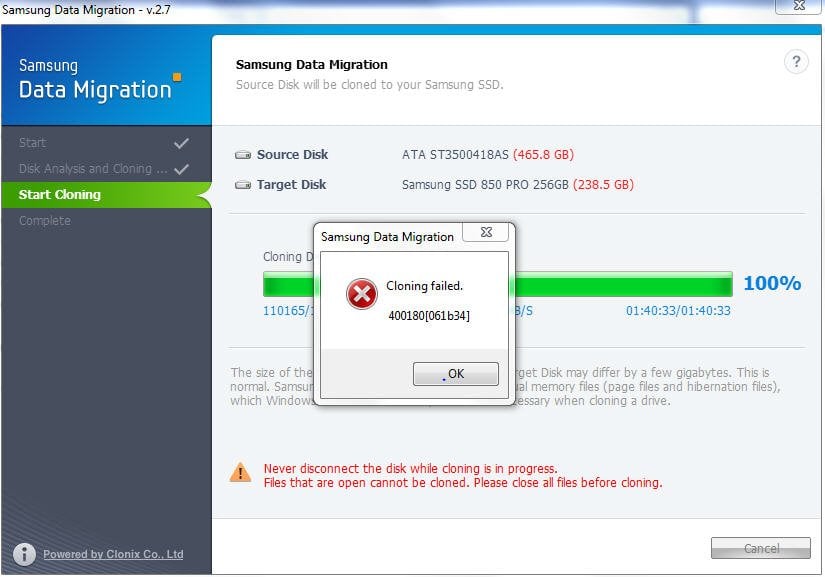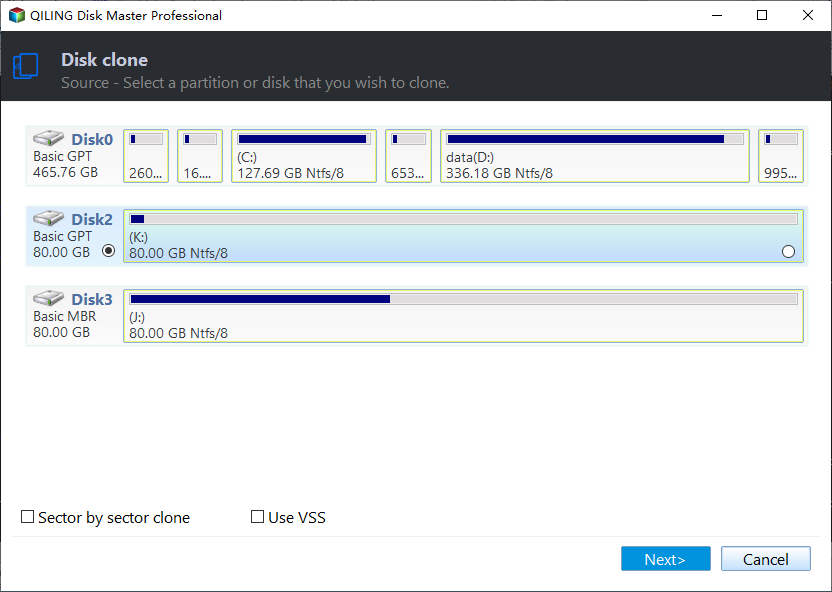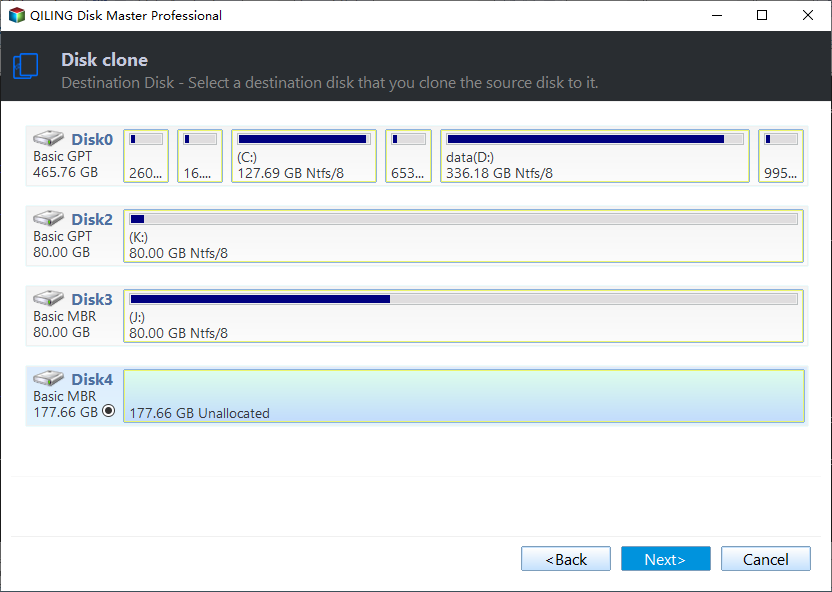Best Samsung M.2 SSD Migration Software in Windows 10/11
Quick Navigation:
- Overview for M.2 form factor and M.2 SSD
- Best Samsung M.2 migration software for Windows 10/11
- Important steps to ensure successful Samsung M.2 SSD migration
- Clone hard drive to Samsung M.2 SSD in Windows 10 step by step
- How to boot from the Samsung M.2 SSD after migration
- Conclusion
Samsung's M.2 SSD is a popular choice for upgrading hard drives, allowing for faster system boots and minimal loading delays. Samsung offers various M.2 SSD options, including the 970 EVO Plus NVMe M.2 SSD 500GB, 860 EVO SATA M.2 SSD 1TB, 970 PRO NVMe M.2 SSD 512GB, and 970 EVO NVMe M.2 SSD 250GB. To make the upgrade, simply select the needed model and follow a guide to successfully migrate your OS and data.
Overview for M.2 form factor and M.2 SSD
The M.2 form factor, also known as NGFF (Next Generation Form Factor), is a modern type of internally mounted expansion card that has replaced the former mSATA standard, offering a more compact and versatile alternative for storage and other expansion needs.
The M.2 form factor is commonly used for SSD data storage, replacing traditional 2.5-inch storage drives. It directly connects to the motherboard via an M.2 connector slot, eliminating the need for cables and keeping the PC's interior organized.
Many people choose M.2 SSDs for their benefits, including faster speeds, but it's worth noting that M.2 drives can utilize either the standard SATA interface or the PCIe interface.
The speed of M.2 SSDs can vary depending on the interface used. While SATA interface M.2 drives may not be significantly faster than standard 2.5-inch drives, those that utilize the NVMe interface protocol (specifically designed for PCIe) can offer much faster speeds.
Best Samsung M.2 migration software for Windows 10/11
Samsung provides users with the Samsung Data Migration software (SDM) to easily clone their existing hard drive disk (HDD) to a Samsung solid-state drive (SSD), ensuring a secure boot process.
If you're hesitant to reinstall Windows and apps from scratch, you can use Samsung's M.2 migration software to transfer your operating system to an M.2 SSD without starting over. The process is relatively straightforward, but it only supports cloning the current system drive, and you may encounter issues like cloning failure or getting stuck.
This software won't work if you want to migrate Samsung M.2 SSD to other brands of disks.
You may want to consider choosing another SSD cloning software, which is supposed to be more compatible, flexible, and reliable.
I'd like to introduce Qiling Disk Master Professional, a tool that perfectly supports M.2 cloning, offering several benefits.
✩ Bootable clone. Users who upgrade their system disk to an M.2 SSD often do so for improved performance. To ensure a secure boot, cloning software should successfully clone all boot-related drives, guaranteeing a seamless transition to the new SSD.
✩ Clone hard drive with different sizes. You may need to replace a larger HDD with a smaller M.2 SSD in some cases, so it must support cloning a large disk to a smaller one.
✩ Supports MBR and GPT disks. If the target SSD is an M.2 NVMe, the PC boots in UEFI mode, and the source disk has Windows 11 installed, the software needs to support GPT disks and may need to �lone MBR to GPT disk without conversion.
✩ Hot clone. You can clone a hard drive within Windows, allowing you to use your computer as usual while the cloning process takes place. This means you can continue to work, browse the internet, or do whatever else you like, without any interruption.
✩ Optimize for the use of SSD. The software will automatically adjust the alignment of SSD partitions to 4K, which can improve the performance and extend the lifespan of the SSD.clone MBR to GPT disk without conversion.
✩ Hot clone. You can clone a hard drive within Windows, allowing you to use your computer as usual while the cloning process takes place. This means you can continue to work, browse the internet, or do whatever else you like, without any interruption.
✩ Optimize for the use of SSD. The software will automatically adjust the alignment of SSD partitions to 4K, which can improve the performance and extend the lifespan of the SSD.
The lucid interface makes all steps easy to follow, even for a computer novice, and allows for a great job to be done. This software supports Windows 11/10, 8.1/8, 7, XP, and Vista. To demonstrate its features, you can download a free trial.
If you're running Windows Server, please refer to Qiling Disk Master Server.
Important steps to ensure successful Samsung M.2 SSD migration
To make the Samsung M.2 clone detected by Windows, ensure that the M.2 SSD is properly connected to the motherboard, and the SATA port is set to AHCI mode in the BIOS. Additionally, the M.
👉Make sure your system supports M.2 SSD.
Before installing an M.2 SSD as a boot drive, ensure your computer's motherboard supports the M.2 slot, as some motherboards may not be compatible, leading to issues like an M.2 SSD not being detected in Windows 10 or 11. Motherboards using Intel z97 and AMD FX 990 chipsets, as well as many notebooks, support M.2 SATA and PCIe SSDs. Check your system specifications and user manual to confirm compatibility.
👉The M.2 spec was designed to accommodate both a SATA and PCIe interface for SSDs.
M.2 SSDs use the same controller as 2.5 inch SATA SSDs, but M.2 PCIe SSDs have a special controller for PCIe protocol. M.2 SSDs can only support one protocol, so you need to connect it to the correct slot (SATA or PCIe) to be recognized in BIOS.
👉Download NVMe drivers for cloning.
Windows 7 doesn't support cloning NVMe SSDs, so you need to install NVMe first and then download the corresponding driver before cloning.
👉Make the partition style compatible with the boot mode.
The partition style of a disk should be compatible with the computer's boot mode. For Legacy BIOS, Master Boot Record (MBR) is required, while for UEFI, GUID Partition Table (GPT) is necessary. When deciding on a partition style, consider factors such as the computer's boot mode, the operating system being installed, and the specific requirements of the disk.
- Systems that support UEFI can boot from an NVMe PCIe SSD, which requires the M.2 NVMe to be formatted with GPT.
- Windows 11 has stricter hardware requirements than Windows 10, specifically requiring a GPT/UEFI and Secure Boot setup, whereas Windows 10 can run on a variety of hardware configurations.
Before cloning, please confirm what partition style you should use for the target disk. Qiling Disk Master supports cloning MBR to GPT/GPT to MBR without conversion, but you may need to convert the partition style of the target drive to match the source drive depending on the circumstances.
To check the current partition style of a disk, open the Run window by pressing Win + R, type "diskmgmt.msc" and hit OK to open disk management, right-click the disk you want to check and click "Properties", and then select the "Volume" tab to check the "Partition style".
❕ Important: If your Samsung M.2 SSD is successfully installed but not detected by your computer, you may need to make some adjustments in the BIOS settings to resolve the issue.
● Press F5 to open Default settings.
● Press F7 to open Advanced settings.
● In the Advanced tab, choose Onboard Device Configuration, and change SATA Mode Configuration to M.2.
Clone hard drive to Samsung M.2 SSD in Windows 10 step by step
After connecting your M.2 SSD to your computer, ensure it is recognized by your system. If it appears in Windows Disk Management, you can proceed with cloning your hard drive to the M.2 SSD by following the subsequent steps.
Steps to use Samsung M.2 SSD clone software:
Step 1. To clone a Samsung M.2 SSD using the Samsung M.2 SSD cloner, go to the Home screen, click on "Clone," then select "Disk Clone" to clone the entire drive or "System Clone" to clone only the operating system.
Step 2. To clone your hard drive, select the source hard drive and then the target M.2 SSD in sequence. This will ensure that the cloning process is done correctly and efficiently.
Step 3. Check the option "SSD Alignment" to accelerate SSD disk speed, then click "Proceed" to start the cloning process.
Helpful tips for Samsung M.2 clone:
✎Edit Partitions: 1. Enable TRIM on the M.2 SSD to maintain its performance and longevity. This is especially important for M.
- Copy without resizing partitions: It will not resize the partition size.
- Add unused space to all partitions: Reallocate the unallocated space to each partition of the target disk.
- Manually adjust partition size: Extend unallocated space to any partition on the target disk you want.
- Convert the destination disk...: To ensure the target disk has the same partition style as the source disk, the command to convert the partition style of the target disk to match the source is used. This command will change the partition style of the target disk to be the same as the source disk, allowing for a seamless transfer of data between the two disks. The command is typically used in conjunction with other commands to ensure a complete and successful transfer of data.
✎Sector By Sector Clone: Clone all sectors, including used and unused ones, from the source disk to the target disk, ensuring the target disk is as large as or larger than the source disk. This process renders the edit partition unusable.
Step 1. When you've finished cloning, shut down the computer. 2. Replace the old drive with the M.
How to boot from the Samsung M.2 SSD after migration
If your PC only has one slot, you can directly replace the old hard drive with the cloned M.2 SSD after the migration process.
If you have multiple drives, you can keep the old drive connected as a secondary drive after cloning. At startup, press the BIOS key (which varies by device) and set the cloned drive as the first boot option. If it boots normally into Windows, the cloning was successful, and you can decide what to do with the old drive, such as wiping it for storage.
If your old drive is partitioned with MBR and your new drive is an M.2 NVMe SSD (GPT), you should also change the boot mode from Legacy BIOS to UEFI.
Conclusion
Qiling Disk Master is a software that allows you to clone a hard drive to a Samsung SSD, as long as the used space of the old drive is smaller than or equal to the Samsung SSD, making it possible to clone a large HDD to a smaller SSD while maintaining a secure boot.
In its advanced edition, the software allows for cloning the MBR to GPT or vice versa, making the cloned SSD bootable, as well as editing partition size to utilize unallocated space. Additionally, it enables the use of backup and restore methods to transfer Windows 10 to an NVMe SSD, even when the computer has only one M.2 slot.
Related Articles
- Seagate DiscWizard Free Alternative | Review and Guide
DiscWizard is a practical cloning tool for Seagate and Maxtor hard drives. But it do have some deficiencies in addition to brand restrictions. So I'd like to share a free alternative to Seagate DiscWizard. - Free Seagate Disk Cloning Software - Qiling Disk Master
How to clone Seagate disk in Windows 10/8/7? Here I'd like to introduce you two effective Seagate disk cloning software with detailed steps. - Fix "Windows detected a hard disk problem" in Win 10/7/8
This article illustrates the possible reasons and corresponding solutions to the Windows detected a hard dsik problem in Windows 11, 10, 8, and 7. Let's get started below. - Best Free Alternative to XXClone for Windows 10/8/7
You will find the best alternative to XXClone and XXClone Pro alternative, just see the details to clone hard drive to SSD without losing data in Windows 10, 8, 7.







